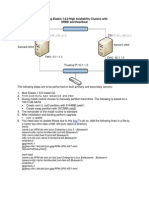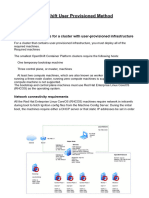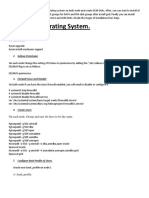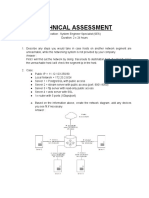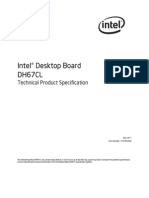DRBD + Heartbeat
DRBD + Heartbeat
Uploaded by
mohitsah0Copyright:
Available Formats
DRBD + Heartbeat
DRBD + Heartbeat
Uploaded by
mohitsah0Original Title
Copyright
Available Formats
Share this document
Did you find this document useful?
Is this content inappropriate?
Copyright:
Available Formats
DRBD + Heartbeat
DRBD + Heartbeat
Uploaded by
mohitsah0Copyright:
Available Formats
INSTALLING AND CONFIGURING DRBD 8.3 AND HEARTBEAT 3.0 ON CENTOS 6 TO BUILD A HIGHLY AVAILABLE FILE SERVER.
DRBD & HEARTBEAT
*********************************************************
INTRODUCTION:DRBD It refers to Distributed Replicated Block Device. It is distributed storage system for the GNU/Linux platform. It consists of a kernel module, several user space management applications and some shell scripts and is normally used on high availability (HA) clusters. DRBD bears similarities to RAID 1, except that it runs over a network. DRBD refers to both the software (kernel module and associated user space tools), and also to specific logical block devices managed by the software. Heartbeat It is a basic heartbeat subsystem for Linux-HA. It will run scripts at initialization, and when machines go up or down. This version will also perform IP address takeover using gratuitous ARPs. It works correctly for a 2-node configuration, and is extensible to larger configurations so in simple language it can be understood as a failover mechanism , whenever your primary host goes down it instantly makes the next secondary host as primary and saves the loss of data.
PREPARING THE SERVERS:You have to take 2 servers and install centos 6 on the both leaving the amount of free space which you wish to use as high available file server. Here leaving free space means just leaving some amount of space in your hard disk, not trying to make a partition because it is a rule that if you mount your partition the DRBD will not consider it and it will generate errors. After we have the OS installed we will configure the machine so that it should be network available and then disable selinux, and iptables and get CentOS up to date. We can activate IPTABLES and selinux back again but for now we disabled it to make things easier to troubleshoot in case we need. Please note that all the below configuration will be done on both the servers until it is directed. Very first I suggest that you should install the NANO editor if its not already with the OS pack because it is much easier to work on NANO(In my view) -Installing NANO #yum install nano - Disabling selinux # nano /etc/selinux/config SELINUX=disabled - Turn Off iptable from system start up # chkconfig iptables off - Update the system # yum update Now we will install some packages that will be necessary for DRBD installation and configuration. # yum install wget ntp #service ntpd start
*********************************************************
Here ntp is network time protocol it is necessary because the both servers will interact and synchronize with each other so if there is time difference it can generate errors. We need to make sure that ntpd is always running to keep both servers time synchronized. # chkconfig ntpd on
HOSTNAME RESOLVE
Now lets suppose we have created two servers :Host name Server1 Server2 test1 test2 ipaddress 10.2.1.230 10.2.1.232
Now we need to make sure that these two servers ping each also other with their hostname and for this we have to open #nano /etc/hosts And write these two lines in the file 10.2.1.230 10.2.1.232 test1 test2
Next try to ping both the servers from each other if they are able to ping then its fine otherwise you need to recheck the /etc/hosts file and also check /etc/sysconfig/network for your hostname and /etc/sysconfig/network-scripts/name of-your-interface for checking your network configuration including IP address, gateway, DNS etc.
CREATING PARTITION
Now we need to create a partition which will be used by DRBD. Please be careful following these steps because the numbers and name could change according machine to machine #fdisk /dev/sda WARNING: DOS-compatible mode is deprecated. It's strongly recommended to Switch off the mode (command 'c') and change display units to sectors (command 'u'). Command (m for help):n (to create new partition) Command action e extended p primary partition (1-4):p (for primary partition)
*********************************************************
select partition (1-4):3 First cylinder (18165-20023, default 18165): Using default value 18165 Last cylinder, +cylinders or +size{K,M,G} (18165-20023, default 20023):+20G In the above line we specified the size of the partition in this case we took it as 20gb Command (m for help):w (to write changes to disk) The changes will be made to disk when you reboot the machine #reboot Now if till now every step is fine we should move further to build and install drbd.
*********************************************************
INSTALLING DRBD
Please note that below anywhere x86_64 is according to the machine architecture which is 64 here and if you are using machine of 32-bit architecture you should replace x86_64 with i386 #yum -y install gcc make automake autoconf flex rpm-build kernel-devel #mkdir -p rpmbuild/{BUILD,BUILDROOT,RPMS,SOURCES,SPECS,SRPMS} #wget http://oss.linbit.com/drbd/8.3/drbd-8.3.11.tar.gz #tar zxvf drbd-8.3.11.tar.gz #cd drbd-8.3.11 drbd-8.3.11]#./configure drbd-8.3.11]#make rpm drbd-8.3.11]#make km-rpm drbd-8.3.11]#cd /root/rpmbuild/RPMS/x86_64 x86_64]#rpm -Uvh drbd-utils-8.3.11-1.el6.x86_64.rpm drbd-km-2.6.32_71.29.1.el6.x86_64-8.3.111.el6.x86_64.rpm Preparing... ########################################### [100%] 1:drbd-utils########################################### [ 50%] 2:drbd-km-2.6.32_71.29.1.################################### [100%] Next, create volumes like follows. #pvcreate /dev/sda3 Physical volume "/dev/sdb1" successfully created #vgcreate vg_r0 /dev/sda3 Volume group "vg_r0" successfully created #lvcreate -L 20G -n lv_r0 vg_r0 Logical volume "lv_r0" created
*********************************************************
Configure DRBD.
Set them on both hosts. #nano /etc/drbd.d/global_common.conf global { #at second line write or modify if previously written as usage-count no; disk { # line 27: add ( detach disks when IO-error ) on-io-error detach; syncer { # line 38: add ( band width for synchronization ) rate 300M; Save the file and exit. Now create a file name main.res #nano /etc/drbd.d/main.res # create new resource main { # DRBD device device /dev/drbd0; # phisical device disk /dev/vg_r0/lv_r0; meta-disk internal; on test1 { # IP address:port address 10.2.1.230:7788; } on test2 {
*********************************************************
address 10.2.1.232:7788; } } Save the file and exit #modprobe drbd #lsmod | grep drbd #drbdadm create-md main --== Thank you for participating in the global usage survey ==-The server's response is: you are the 20298th user to install this version Writing meta data... initializing activity log NOT initialized bitmap New drbd meta data block successfully created. success Now we should start drbd service on both the servers. May I remind one more time till now what have done should be same on both the servers and will be same in both in further configuration until it is directed. #service drbd start Starting DRBD resources: [ d(main) s(main) n(main) ]. #chkconfig drbd on # echo "/sbin/modprobe drbd" >> /etc/rc.local Make a Host be primary, then synchronization starts. #cat /proc/drbd version: 8.3.11 (api:88/proto:86-96) GIT-hash: 0de839cee13a4160eed6037c4bddd066645e23c5 build by root@www01.server.world, 2011-07-15 15:26:20 0: cs:Connected ro:Secondary/Secondary ds:Inconsistent/Inconsistent C r----ns:0 nr:0 dw:0 dr:0 al:0 bm:0 lo:0 pe:0 ua:0 ap:0 ep:1 wo:b oos:20970844
*********************************************************
run the below command on any one server which you wish to make primary. In this case lets make test1 a primary server so the commands will be run on test1 server. #drbdsetup /dev/drbd0 primary o # set primary #cat /proc/drbd version: 8.3.11 (api:88/proto:86-96) GIT-hash: 0de839cee13a4160eed6037c4bddd066645e23c5 build by root@www01.server.world, 2011-07-15 15:26:20 0: cs:SyncSource ro:Primary/Secondary ds:UpToDate/Inconsistent C r----ns:940444 nr:0 dw:0 dr:948480 al:0 bm:56 lo:136 pe:3130 ua:1979 ap:0 ep:1 wo:b oos:20042916 [>....................] sync'ed: 4.5% (19572/20476)M finish: 0:03:57 speed: 84,356 (84,356) K/sec after few minutes later, synchronization completes and the status turns like follows. #cat /proc/drbd version: 8.3.11 (api:88/proto:86-96) GIT-hash: 0de839cee13a4160eed6037c4bddd066645e23c5 build by root@www01.server.world, 2011-07-15 15:26:20 0: cs:Connected ro:Primary/Secondary ds:UpToDate/UpToDate C r----ns:20970844 nr:0 dw:0 dr:20971508 al:0 bm:1277 lo:0 pe:0 ua:0 ap:0 ep:1 wo:b oos:0 Configuration completes. It's OK to create a file system on DRBD device and mount it on a primary host to use it. #mkfs -t ext4 /dev/drbd0 #mkdir /drbd0 #mount /dev/drbd0 /drbd0 #touch /drbd0/test.txt # create a test file
If you'd like to mount DRBD device on secondary Host, unmount DRBD device on primary Host first and make primary Host be secondary. Next make secondary Host be primary and mount DRBD device. In the way we can also check the replication of data as the test.txt file which we created will show on secondary host when we will mount the DRBD device on the secondary host.
*********************************************************
########### on Primary Host ########### #umount /drbd0 #drbdadm secondary main # set secondary
########### on Secondary Host ########### #drbdadm primary main #mount /dev/drbd0 /drbd0 Now when we will list the directories and files of /drbd it will show test.txt. # set primary
*********************************************************
HEARTBEAT INSTALLATION AND CONFIGURATION
# rpm -Uvh http://download.fedora.redhat.com/pub/epel/6/x86_64/epel-release-65.noarch.rpm # nano /etc/yum.repos.d/epel.repo enabled=0 # yum --enablerepo=epel install heartbeat Create the following file on both servers with the exact same content: # nano /etc/ha.d/ha.cf logfile /var/log/ha-log logfacility local0 keepalive 2 deadtime 30 initdead 120 bcast Auto_eth0 udpport 694 auto_failback on node test1 node test2 The next step is to create the resource file for heartbeat on both servers with exact same content again: # nano /etc/ha.d/haresources test1 IPaddr::10.2.1.200/24/Auto_eth0 first word is the hostname of the primary server then the IP 10.2.1.200 is the one I choose to be the virtual IP to be moved to the slave in case of a failure. The last thing is to create the authentication file on both servers again with the same content:
*********************************************************
# nano /etc/ha.d/authkeys auth 2 2 sha1 my-password This password file should only be readable by the root user: # chmod 600 /etc/ha.d/authkeys Ok now we should be ready to go Lets test it!! On both servers start heartbeat service: # service heartbeat start on server1 # ifconfig Auto_eth0 Link encap:Ethernet HWaddr 08:00:27:95:AB:B1
inet addr:10.2.1.230 Bcast:10.2.1.255 Mask:255.255.255.0 inet6 addr: fe80::a00:27ff:fe95:abb1/64 Scope:Link UP BROADCAST RUNNING MULTICAST MTU:1500 Metric:1 RX packets:2189638 errors:0 dropped:0 overruns:0 frame:0 TX packets:30442386 errors:0 dropped:0 overruns:0 carrier:0 collisions:0 txqueuelen:1000 RX bytes:188528923 (179.7 MiB) TX bytes:45853044392 (42.7 GiB) Auto_eth0:0 Link encap:Ethernet HWaddr 08:00:27:95:AB:B1 inet addr:10.2.1.200 Bcast:10.2.1.255 Mask:255.255.255.0 UP BROADCAST RUNNING MULTICAST MTU:1500 Metric:1 lo Link encap:Local Loopback inet addr:127.0.0.1 Mask:255.0.0.0 inet6 addr: ::1/128 Scope:Host UP LOOPBACK RUNNING MTU:16436 Metric:1 RX packets:305 errors:0 dropped:0 overruns:0 frame:0 TX packets:305 errors:0 dropped:0 overruns:0 carrier:0
*********************************************************
collisions:0 txqueuelen:0 RX bytes:35012 (34.1 KiB) TX bytes:35012 (34.1 KiB)
Testing DRBD fail over
You can shut down server1 or simply stop heartbeat service: On server1: # service heartbeat stop On server2: # ifconfig Auto_eth0 Link encap:Ethernet HWaddr 08:00:27:8F:3B:50
inet addr:10.2.1.232 Bcast:10.2.1.255 Mask:255.255.255.0 inet6 addr: fe80::a00:27ff:fe8f:3b50/64 Scope:Link UP BROADCAST RUNNING MULTICAST MTU:1500 Metric:1 RX packets:30447253 errors:0 dropped:0 overruns:0 frame:0 TX packets:2138369 errors:0 dropped:0 overruns:0 carrier:0 collisions:0 txqueuelen:1000 RX bytes:45799991579 (42.6 GiB) TX bytes:173195698 (165.1 MiB) Auto_eth0:0 Link encap:Ethernet HWaddr 08:00:27:8F:3B:50 inet addr:10.2.1.200 Bcast:10.0.4.255 Mask:255.255.255.0 UP BROADCAST RUNNING MULTICAST MTU:1500 Metric:1 lo Link encap:Local Loopback inet addr:127.0.0.1 Mask:255.0.0.0 inet6 addr: ::1/128 Scope:Host UP LOOPBACK RUNNING MTU:16436 Metric:1 RX packets:208 errors:0 dropped:0 overruns:0 frame:0 TX packets:208 errors:0 dropped:0 overruns:0 carrier:0 collisions:0 txqueuelen:0
*********************************************************
RX bytes:23480 (22.9 KiB) TX bytes:23480 (22.9 KiB) Till this point if your machine responds in the same manner , congratulations you have now installed and configured DRBD with Heartbeat. If you get any error refer to /var/log/messages to get more detail.
You might also like
- Ebook Setup EA Padu Viral V.100Document50 pagesEbook Setup EA Padu Viral V.100raszcor lolitaq100% (1)
- An A-Z Index of Commands: Windows PowershellDocument8 pagesAn A-Z Index of Commands: Windows PowershelladminakNo ratings yet
- Elastix 2.3 HA ClusterDocument12 pagesElastix 2.3 HA Clusterleossj2No ratings yet
- Netbsd InstallDocument6 pagesNetbsd InstallAndreNo ratings yet
- Diskless Remote Boot in LinuxDocument14 pagesDiskless Remote Boot in Linuxkarthickk02No ratings yet
- Elastix HA ClusterDocument11 pagesElastix HA ClusterIng Diego Eduardo Morales LopezNo ratings yet
- Frappe Framework Installation On Ubuntu 20 - 04 by GorzDocument11 pagesFrappe Framework Installation On Ubuntu 20 - 04 by GorzFavour GodspowerNo ratings yet
- A Elastix ClusteringDocument7 pagesA Elastix ClusteringCesar HernandezNo ratings yet
- (Linux) DRBD - Heartbeat (ActivePassive High Availability Cluster)Document3 pages(Linux) DRBD - Heartbeat (ActivePassive High Availability Cluster)Sonia Andrea Bautista AmayaNo ratings yet
- Howto - Bandwidth Management For Adsl With OpenbsdDocument14 pagesHowto - Bandwidth Management For Adsl With OpenbsdjuanjoescobarNo ratings yet
- Squid Squidguard On CentosDocument7 pagesSquid Squidguard On CentosZeeshan MuhammadNo ratings yet
- DHCP Open BSDDocument4 pagesDHCP Open BSDsyusmaNo ratings yet
- How To Configure Pxe Boot Server in LinuxDocument7 pagesHow To Configure Pxe Boot Server in Linuxapi-284453517100% (1)
- Openshift Installation StepsDocument18 pagesOpenshift Installation Stepshtv6041No ratings yet
- How To Setup A Clonezilla ServerDocument12 pagesHow To Setup A Clonezilla ServerWalther QuadrosNo ratings yet
- Highly Availability SetupDocument17 pagesHighly Availability SetupMayureshwar NikteNo ratings yet
- Linux DHCP Server ConfigurationDocument8 pagesLinux DHCP Server ConfigurationEdmund OchiengNo ratings yet
- R12 Installation 64 Bit On OEL 5 Update 5Document18 pagesR12 Installation 64 Bit On OEL 5 Update 5kkpareekNo ratings yet
- Disk Less Using NXDDocument9 pagesDisk Less Using NXDRazid AliNo ratings yet
- LinuxmanualDocument12 pagesLinuxmanualJose Navas TapiaNo ratings yet
- Linux Interview QuestionsDocument52 pagesLinux Interview Questionsvinnuthegreat100% (1)
- Fedora ServerDocument38 pagesFedora ServerTestoje TestovićNo ratings yet
- Installation OpenMeetings 5.0.0 On Ubuntu 20.04 LtsDocument17 pagesInstallation OpenMeetings 5.0.0 On Ubuntu 20.04 LtsLuis Agustin Suaña JalaNo ratings yet
- OpenGTS 2.3.9 Ubuntu 10.04Document10 pagesOpenGTS 2.3.9 Ubuntu 10.04jeaneric82No ratings yet
- Configuring Diskless Clients With Red Hat Enterprise Linux 0Document5 pagesConfiguring Diskless Clients With Red Hat Enterprise Linux 0Amardeep KishoreNo ratings yet
- DRBD LVS Install-Configure HowToDocument6 pagesDRBD LVS Install-Configure HowToedi12321No ratings yet
- Install Red Hat For OracleDocument5 pagesInstall Red Hat For OracleUzair PatelNo ratings yet
- Install Oracle RAC 11gr2 On Redhat 6.6Document5 pagesInstall Oracle RAC 11gr2 On Redhat 6.6Binh VuNo ratings yet
- Compiling Software From SourceDocument3 pagesCompiling Software From SourceTunas AndirantoNo ratings yet
- Solaris Questions and AnswersDocument25 pagesSolaris Questions and Answersankit0076No ratings yet
- Linux Interview QuestionsDocument51 pagesLinux Interview Questionsseenu933No ratings yet
- 1 Install The Base System: Boot From Your Fedora Core 5 DVD or CD (CD 1)Document20 pages1 Install The Base System: Boot From Your Fedora Core 5 DVD or CD (CD 1)antonyabirawaNo ratings yet
- Open Vswitch With DPDK : Hands-On LabDocument17 pagesOpen Vswitch With DPDK : Hands-On LabHans MaiserNo ratings yet
- How To Install Linux, Apache, Mysql, PHP (Lamp) Stack On Debian 9 StretchDocument24 pagesHow To Install Linux, Apache, Mysql, PHP (Lamp) Stack On Debian 9 StretchHenry CahyoNo ratings yet
- Server Linux NotesDocument35 pagesServer Linux NotesChand Basha100% (2)
- Vcloud Director Installation Part 1 - Database: This Is Part 1 of The VCD 9.0 Installation GuideDocument15 pagesVcloud Director Installation Part 1 - Database: This Is Part 1 of The VCD 9.0 Installation GuideprakashNo ratings yet
- Ldom Oracle VM For SparcDocument89 pagesLdom Oracle VM For Sparcrajlvu100% (1)
- 7/07/cloud Computing Centos Rocks EucalyptusDocument11 pages7/07/cloud Computing Centos Rocks EucalyptusSaravanaRaajaaNo ratings yet
- Mendel Linux HowtoDocument17 pagesMendel Linux HowtoDavidNo ratings yet
- L2DC Linux Server GuideDocument11 pagesL2DC Linux Server GuidenekysnemiaNo ratings yet
- Linux HPC Cluster Setup GuideDocument28 pagesLinux HPC Cluster Setup GuideEdmund OchiengNo ratings yet
- Instal Guide Freepbx Redhat6Document15 pagesInstal Guide Freepbx Redhat6Anta MasimmoNo ratings yet
- RedHat Linux 9Document22 pagesRedHat Linux 9umankumar845No ratings yet
- LDOMSDocument19 pagesLDOMSvishavanath vkNo ratings yet
- Instructions For Installation Hyperledger Composer On Ubuntu 16.04 LTSDocument12 pagesInstructions For Installation Hyperledger Composer On Ubuntu 16.04 LTSSaikat MukhopadhyayNo ratings yet
- Tinydns On Centos 5.4Document4 pagesTinydns On Centos 5.4VL RickettsNo ratings yet
- Asterisk High AvailabilityDocument21 pagesAsterisk High AvailabilityHenry100% (2)
- HP How TosDocument8 pagesHP How TosDharmendra PatelNo ratings yet
- Oracle 12cR2 InstallationsDocument48 pagesOracle 12cR2 InstallationsNasir MahmoodNo ratings yet
- Unix Toolbox: 1 SystemDocument48 pagesUnix Toolbox: 1 Systemarevshar4779No ratings yet
- Technical Assessment For Deployment Support Engineer - Hery MunanzarDocument6 pagesTechnical Assessment For Deployment Support Engineer - Hery MunanzarMuhammad HafizNo ratings yet
- Snort Ids Tutorial PDFDocument18 pagesSnort Ids Tutorial PDFAlberto Acevedo AliagaNo ratings yet
- Template SNMP IBM Director AgentDocument3 pagesTemplate SNMP IBM Director AgentDamian BustamanteNo ratings yet
- How To Build A Duplicate Standby File & Print Server Using Windows 2003 Server and Windows XPDocument8 pagesHow To Build A Duplicate Standby File & Print Server Using Windows 2003 Server and Windows XPElectroMan53No ratings yet
- Montar GateWay y DHCP Server en Ubuntu 12.04Document3 pagesMontar GateWay y DHCP Server en Ubuntu 12.04juanpe69No ratings yet
- ManualDocument12 pagesManualhmoeenNo ratings yet
- CISCO PACKET TRACER LABS: Best practice of configuring or troubleshooting NetworkFrom EverandCISCO PACKET TRACER LABS: Best practice of configuring or troubleshooting NetworkNo ratings yet
- Configuration of a Simple Samba File Server, Quota and Schedule BackupFrom EverandConfiguration of a Simple Samba File Server, Quota and Schedule BackupNo ratings yet
- Evaluation of Some Intrusion Detection and Vulnerability Assessment ToolsFrom EverandEvaluation of Some Intrusion Detection and Vulnerability Assessment ToolsNo ratings yet
- Evaluation of Some Windows and Linux Intrusion Detection ToolsFrom EverandEvaluation of Some Windows and Linux Intrusion Detection ToolsNo ratings yet
- Configuration of a Simple Samba File Server, Quota and Schedule BackupFrom EverandConfiguration of a Simple Samba File Server, Quota and Schedule BackupNo ratings yet
- DRBD-Cookbook: How to create your own cluster solution, without SAN or NAS!From EverandDRBD-Cookbook: How to create your own cluster solution, without SAN or NAS!No ratings yet
- Basic Switch ConfigurationDocument4 pagesBasic Switch ConfigurationanikajudyNo ratings yet
- File System ImplementationDocument35 pagesFile System ImplementationSát Thủ Vô TìnhNo ratings yet
- DX DiagDocument28 pagesDX DiagNaj AlNo ratings yet
- Installation of Hadoop in Windows10Document4 pagesInstallation of Hadoop in Windows10Bindu MadhuriNo ratings yet
- How To Create DMZ For EBS R12Document16 pagesHow To Create DMZ For EBS R12Praveen KumarNo ratings yet
- 04 Laboratory Exercise 1Document4 pages04 Laboratory Exercise 1Christian LeonesNo ratings yet
- Operating System SlidesDocument3 pagesOperating System SlidesWEBSITE NINJANo ratings yet
- Synchronous Data Link Control and DerivativesDocument5 pagesSynchronous Data Link Control and Derivativesmana1345No ratings yet
- MemoryAbstractionDocument23 pagesMemoryAbstractionTu TuNo ratings yet
- Iegand Egistration Eader: Wiegand Registration Reader Installation Manual SpecificationsDocument8 pagesIegand Egistration Eader: Wiegand Registration Reader Installation Manual SpecificationsStephanebNo ratings yet
- LogcatDocument13 pagesLogcatyashvirharripersadhNo ratings yet
- DH67CL TechProdSpec02Document91 pagesDH67CL TechProdSpec02tobiismadaraNo ratings yet
- Data HazardsDocument29 pagesData Hazardssivakumarb92No ratings yet
- Magic Lantern v2.3 Install Guide: WWW - Magiclantern.fmDocument6 pagesMagic Lantern v2.3 Install Guide: WWW - Magiclantern.fmFedericoNo ratings yet
- Unix MCQDocument26 pagesUnix MCQKiran DatarNo ratings yet
- Topic02 Data AcquisitionDocument26 pagesTopic02 Data AcquisitionHappy Plants BDNo ratings yet
- Ds LIFEBOOK U9413Document8 pagesDs LIFEBOOK U9413Bau FroschNo ratings yet
- Cisco 123Document14 pagesCisco 123Kharolina BautistaNo ratings yet
- Windows Server 2012 R2 x64 VL Standart Datacenter PT BR Original Download Torrent TPB PDFDocument1 pageWindows Server 2012 R2 x64 VL Standart Datacenter PT BR Original Download Torrent TPB PDFEvandro Amaral RodriguesNo ratings yet
- Course AZ-104T00-A: Microsoft Azure Administrator: Course Outline Module 1: IdentityDocument5 pagesCourse AZ-104T00-A: Microsoft Azure Administrator: Course Outline Module 1: IdentitySatishNo ratings yet
- CS8461 Os Lab Manual PrintDocument58 pagesCS8461 Os Lab Manual Printkurinji67% (3)
- 2016-10-03 NYCHA Maximo Siebel Status Closed (Audit Trail)Document4 pages2016-10-03 NYCHA Maximo Siebel Status Closed (Audit Trail)Progress QueensNo ratings yet
- OpenScape Business V1 Administrator DocumentationDocument1,407 pagesOpenScape Business V1 Administrator Documentationsorin birou100% (2)
- Key Grabber Read MeDocument3 pagesKey Grabber Read MewedsonjswdNo ratings yet
- No Review Review This Product: Acer Extensa E210 Desktop ComputerDocument1 pageNo Review Review This Product: Acer Extensa E210 Desktop Computernitamashile102388No ratings yet
- Abb 800xa Installation HandbookDocument79 pagesAbb 800xa Installation HandbookmanoharprvnNo ratings yet
- CPU-Upgrade - MSI P4M900M2-L (MS-7255 v2.0) Processor Support and SpecificationsDocument15 pagesCPU-Upgrade - MSI P4M900M2-L (MS-7255 v2.0) Processor Support and SpecificationsAlexandro HotnandoNo ratings yet
- Asus Test ReportDocument4 pagesAsus Test ReportFerry RiantoNo ratings yet







